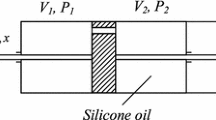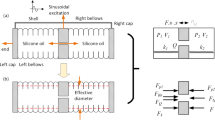Abstract
Micro-vibrations in satellites mainly originate from the control moment gyroscope because of its mass imbalance, which seriously affect the image accuracy of high-resolution optical payload, so it must be isolated. Bellows-type fluid viscous damper (FVD) can be used to isolate micro-vibrations. In this paper, a simplified model of the damping element in bellows-type FVD under medium- and high-frequency excitation is proposed according to the concept of bellows effective area. Based on this theoretical model, nonlinear stiffness and damping at different design parameters are extracted by nonlinear fitting method. Then, the main cause of nonlinear stiffness and damping is analyzed by the velocity distribution in the cross section of damping orifice. The factors that affect the intensity of nonlinear stiffness and damping are discussed by using the flow resistance. The results show that the velocity term in the corrected hydraulic resistance is the cause of nonlinear damping and stiffness. Damping orifice diameter, length and silicone oil viscosity will affect the intensity of nonlinear characteristics of this damper. At low viscosity, the nonlinear damping is more obvious. The larger the diameter, the more obvious the nonlinear damping. In the frequency domain between 1 and 200 Hz, the velocity index is not a constant, but changes with frequency. Hydraulic stiffness can be divided by linear stiffness and nonlinear stiffness; both of them can affect the elastic force.






























Similar content being viewed by others
References
Lin, L., et al.: The influence of flywheel micro vibration on space camera and vibration suppression. Mech. Syst. Signal Process. 100, 360–370 (2018)
Hur, G.: Isolation of micro-vibrations due to reaction wheel assembly using a source-path-receiver approach for quantitative requirements. J. Vib. Control 25, 1424–1435 (2019)
Stabile, A., et al.: A 2-collinear-DoF strut with embedded negative-resistance electromagnetic shunt dampers for spacecraft micro-vibration. Smart Mater. Struct. 26(4), 045031 (2017)
Kwon, S.C., et al.: Viscoelastic multilayered blade-type passive vibration isolation system for a spaceborne cryogenic cooler. Cryogenics 105, 102982 (2020)
Kawak, B.J.: Development of a low-cost, low micro-vibration CMG for small agile satellite applications. Acta Astronaut. 131, 113–122 (2017)
Kawak, B.J., Cabon, B.H., Aglietti, G.S.: Innovative viscoelastic material selection strategy based on dma and mini-shaker tests for spacecraft applications. Acta Astronaut. 131, 18–27 (2017)
Shi, W.K., et al.: Modeling and dynamic properties of a four-parameter zener model vibration isolator. Shock Vib. (2016)
Ma, G., et al.: Active suspension method and active vibration control of a hoop truss structure. AIAA J. 56, 1689–1695 (2018)
Asadi, E., et al.: A new adaptive hybrid electromagnetic damper: modelling, optimization, and experiment. Smart Mater. Struct. 24(7), 075003 (2015)
Oh, H.: Experimental demonstration of an improved magneto-rheological fluid damper for suppression of vibration of a space flexible structure. Smart Mater. Struct. 13(5), 1238–1244 (2004)
Davis, P., Cunningham, D., Harrell, J.: Advanced 1.5 Hz passive viscous isolation system. In: 35th Structures, Structural Dynamics, and Materials Conference (1994)
Tosovsky, J., Janulik, V., Ruebsamen, D.T.: Adaptive three parameter isolator assemblies including external magneto-rheological valves
Martinez, D., Pagan, J., Goold, R.: Isolators including damper assemblies having variable annuli and spacecraft isolation systems employing the same (2017)
Likun, L., Gangtie, Z., Wenhu, H.: Study of liquid viscosity dampers in octo-strut platform for whole-spacecraft vibration isolation. Acta Astronaut. 58(10), 515–522 (2006)
Wang, J., et al.: A test method of dynamic damping coefficient of micro-vibration isolators. Hangkong Xuebao/acta Aeronautica Et Astronautica Sinica 35(2), 454–460 (2014)
Jing, X.J., Lang, Z.Q.: Frequency domain analysis of a dimensionless cubic nonlinear damping system subject to harmonic input. Nonlinear Dyn. 58(3), 469–485 (2009)
Xing, W., Hongxiang, Y., Gangtie, Z.: Enhancing the isolation performance by a nonlinear secondary spring in the Zener model. Nonlinear Dyn. 87(4), 1–13 (2016)
Laalej, H., et al.: MR damper based implementation of nonlinear damping for a pitch plane suspension system. Smart Mater. Struct. 21(4), 045006 (2012)
Narkhede, D.I., Sinha, R.: Behavior of nonlinear FVDs for control of shock vibrations. J. Sound Vib. 333(1), 80–98 (2014)
Jie, W., Shougen, Z., Dafang, W.: A numerical study on the performance of nonlinear models of a microvibration isolator. Shock Vib. 2014, 1–23 (2014)
Jiao, X, Zhao, Y., Ma, W.: Nonlinear dynamic characteristics of a micro-vibration FVD. Nonlinear Dyn. (2018)
Tabar, A.M.: Linearization of seismic response of structures equipped with nonlinear viscous dampers using perturbation technique. Eng. Struct. 184, 459–468 (2019)
Yin, Y., et al.: Hydraulic damping nonlinearity of a compact hydro-pneumatic suspension considering gas-oil emulsion. Vibroeng. Proc. 30, 68–71 (2020)
Jith, J., Sarkar, S.: A model order reduction technique for systems with nonlinear frequency dependent damping. Appl. Math. Model. 77, 1662–1678 (2020)
Zhu, R., Guo, T., Mwangilwa, F.: Development and test of a self-centering fluidic viscous damper. Adv. Struct. Eng. 1369433220920464 (2020)
Kizilay, H.S., Cigeroglu, E.: Frequency Domain Nonlinear Modeling and Analysis of Liquid-Filled Column Dampers. Nonlinear Dynamics and Control, pp. 43–57. Springer, Cham (2020)
Dion, C., et al.: Real-time dynamic substructuring testing of viscous seismic protective devices for bridge structures. Eng. Struct. 33(12), 3351–3363 (2011)
Takeda, S.: Elastomechanical researches on the metallic bellows (beam-theoretical and disc theoretical considerations). Report Techn. Coll. Hosei Univ, Vol. 16 No. 1 (1963)
Langhaar, H.L.: Steady flow in the transition length of straight tube. Trans. ASME 64 (1942)
He, L., Zheng, G.T.: Effect of viscous heating in fluid damper on the vibration isolation performance. Mech. Syst. Signal Process. 21(8), 3060–3071 (2007)
Wang, X., Wu, H., Yang, B.: Micro-vibration suppressing using electromagnetic absorber and magnetostrictive isolator combined platform. Mech. Syst. Signal Process. 139, 1066061–10660620 (2020)
Lee, D.O., Park, G., Han, J.H.: Hybrid isolation of micro vibrations induced by reaction wheels. J. Sound Vib. 363, 1–17 (2016)
Singiresu, S.R.: Mechanical Vibrations. Addison Wesley, Boston, MA (1995)
Acknowledgements
This work was supported by the China Postdoctoral Science Foundation (No. 2019M63244) and National Basic Research Program of China (No. 11803034).
Author information
Authors and Affiliations
Corresponding author
Ethics declarations
Conflict of interest
The authors declare that they have no conflict of interest.
Additional information
Publisher's Note
Springer Nature remains neutral with regard to jurisdictional claims in published maps and institutional affiliations.
Rights and permissions
About this article
Cite this article
Jiao, X., Zhang, J., Yan, Y. et al. Research on nonlinear stiffness and damping of bellows-type fluid viscous damper. Nonlinear Dyn 103, 215–237 (2021). https://doi.org/10.1007/s11071-020-06146-9
Received:
Accepted:
Published:
Issue Date:
DOI: https://doi.org/10.1007/s11071-020-06146-9




